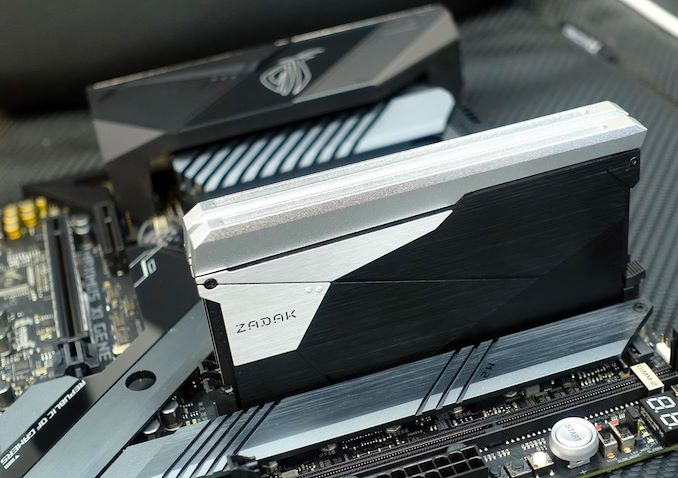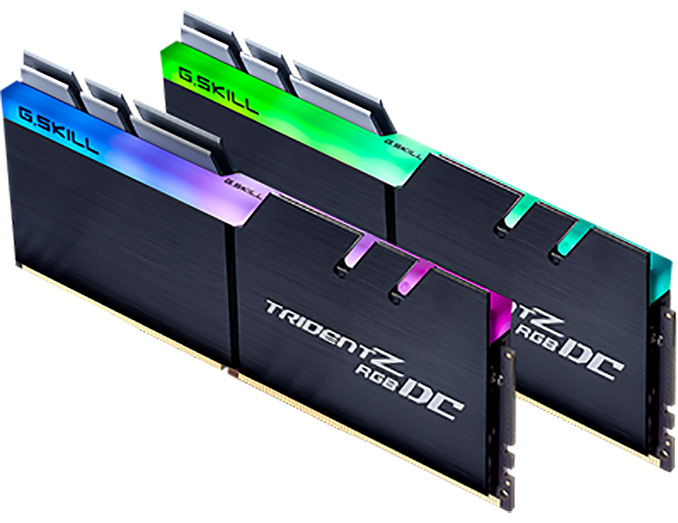Intel to Support 128GB of DDR4 on Core 9th Gen Desktop Processors
by Ian Cutress on October 15, 2018 9:00 AM EST
One of today’s announcements threw up an interesting footnote worthy of further investigation. With its latest products, HP announced that their mainstream desktop platforms would be shipped with up to 32GB of memory, which was further expandable up to 128GB. Intel has confirmed to us, based on new memory entering the market, that there will be an adjustment to the memory support of the latest processors.
State of Play
Normally mainstream processors only support 64GB, by virtue of two memory channels, two DIMMs per memory channel (2DPC), and the maximum size of a standard consumer UDIMM being 16GB of DDR4, meaning 4x16GB = 64GB. However the launch of two different technologies, both double height double capacity 32GB DDR4 modules from Zadak and G.Skill, as well as new 16Gb DDR4 chips coming from Samsung, means that technically in a consumer system with four memory slots, up to 128GB might be possible.
With AMD, the company has previously stated that its memory controller can support future memory that comes to market (with qualification), however Intel has been steadfast in limiting its memory support on its chips specifically within the specification. HP is now pre-empting the change it its latest launch with the following footnote:
This has forced Intel into a statement, which reads as the following:
The new 9th Gen Intel Core processors memory controller is capable of supporting DDR4 16Gb die density DIMMs which will allow the processors to support a total system memory capacity of up to 128GB when populating both motherboard memory channels with 2 DIMMs per Channel (2DPC) using these DIMMs. As DDR4 16Gb die density DIMMs have only recently become available, we are now validating them, targeting an update in a few months’ time.
At present Intel is only talking about the new Core 9th Gen processors that are set to hit the market on October 19th, which are the Core i9-9900K, the Core i7-9700K, and the Core i5-9600K. There has been no statement on previous generations of processors that support DDR4, or if there is any change on the high-end desktop platform for 256GB support.
Pricing for the newest 32GB memory modules is not expected to be cheap. A current 4x16GB kit comes in at around $550 for DDR4-2666, which is a ‘maximum supported’ memory kit, so a 4x32GB kit could easily run double plus a bit extra, perhaps in the $1200-$1600 range. That would put a single memory module at $300-$400, essentially costing more than most DDR4-capable processors.
Pricing aside, the main reason for the memory modules is likely not for changing peak memory capacity, but for enabling 2x32GB configurations, for prosumers that need 64GB in a small volume system. This is perhaps why Samsung’s first DDR4 32GB modules were SO-DIMM modules, to enable mobile workstations.
We will be monitoring the situation if more processors will be supporting these modules. G.Skill is sending us a sample and Zadak has stated we should be on the list, as ASUS ROG will be the first motherboard vendor to support both. Once we get a motherboard in to test we will see how well they perform.














24 Comments
View All Comments
MrSpadge - Monday, October 15, 2018 - link
You may want to conider closing programs you're finished using ;)WithoutWeakness - Monday, October 15, 2018 - link
Any sort of virtualization workload can quickly consume lots of memory. As a software developer, if you were spinning up multiple VMs locally to test your code across several operating system versions you could quickly gobble up 32GB or more of RAM on the host system depending on your program and how many VMs are running.Any sort of graphics, video, or 3D work can easily chew up lots of memory as well. Adobe's tools like Photoshop, After Effects, and Premiere can use tons of RAM if it is available and you are working with large files.
PeachNCream - Monday, October 15, 2018 - link
Can confirm this. I've got GIMP, Kdenlive, and Audacity open plus Firefox and occasionally Pinta (depending on whether its more efficient than using GIMP for the task at hand) while I'm recording or editing a video and I find an alarming amount of RAM consumed. Of course, it's nothing like Adobe's suite when it comes to inefficiency, but I had to spring for 8GB for my Linux box because 4GB wasn't cutting it.jospoortvliet - Wednesday, October 17, 2018 - link
Kdenlive rendering can bring my 16gb system to its knees - so yeah same here. And gimp on large images... heavy too.Plus browser tabs and virtualization - my next system won't be a mini itx simply because I don't want to be limited to 2 memory slots anymore... micro-atx it is
(I know there are mini-itx boards with 4 so-dimm slots. Maybe, maybe.)
HStewart - Monday, October 15, 2018 - link
With modern 64 bit graphics applications, I can see even 16G is not enough. With Photoshop CS for example with larger image - it needs a lot of ram also - with PowerDirector with 4K movie it similar. Lightwave 3D is pretty efficient when it comes to memory but more memory the better. Vue 2016 is heavy on memory, I feel even 16G is low.Of course VM's used alot - my Work thinkpad has 12G and I used 4G VM. I fortunately only used single VM because of older compiler and I actually have a lab in my house full of machines.
But I would find it hard to use 64G of ram - not to mention 128G - but then again I remember times when even 4G of memory was out of question and even 1G of ram was unheard of.
The problem is memory so available now in sizes - that developers have become lazy.
haukionkannel - Tuesday, October 16, 2018 - link
So true! Video Editing with 128GB of memory would be much better than with 16... It would be even better with 512GB of memory, but for that I need some expensive pro rig...James5mith - Monday, October 15, 2018 - link
How about some articles on the actual availability of 32GB UDIMMs/SO-DIMMs?I know they are providing to OEMs first, but I haven't seen a single listing for the modules themselves for sale.
What is the timeline?
Cidona - Tuesday, October 16, 2018 - link
I've been thinking about getting a Clevo laptop in the near term and would like to get 2x32GB (SODIMM) sticks installed, keeping two slots open for possible future upgrade to fill the other two slots with a further 2x32GB.Don't know about any of the sources below but they are the only locations I've seen with stock or what seems to be stock on the way...
https://www.campuspoint.de/samsung-m471a4g43mb1-ct...
https://xceldatasolution.com/product-view/M471A4G4...
https://www.ebay.com/itm/Single-32GB-DDR4-2400-Sod...
https://www.ramcity.com.au/ram/ddr4/2666/sodimm/M4...
vailr - Monday, October 15, 2018 - link
Don't forget to update the "ASUS Shows Off ROG Dominus Extreme Motherboard" which incorrectly says: "support for up to 512 GB of ECC or non-ECC system memory across twelve RAM slots". 12 slots x 32 Gb = 384 Gb maximum.axfelix - Monday, October 15, 2018 - link
If only they'd been able to add LPDDR4 support to Whiskey Lake too. between the Spectre/Markdown fixes and the four cores from Kaby-R they're finally close to making something I want to replace my Haswell notebook with, and it's nuts that it's taken this long, but I can't justify LPDDR3 in 2019.